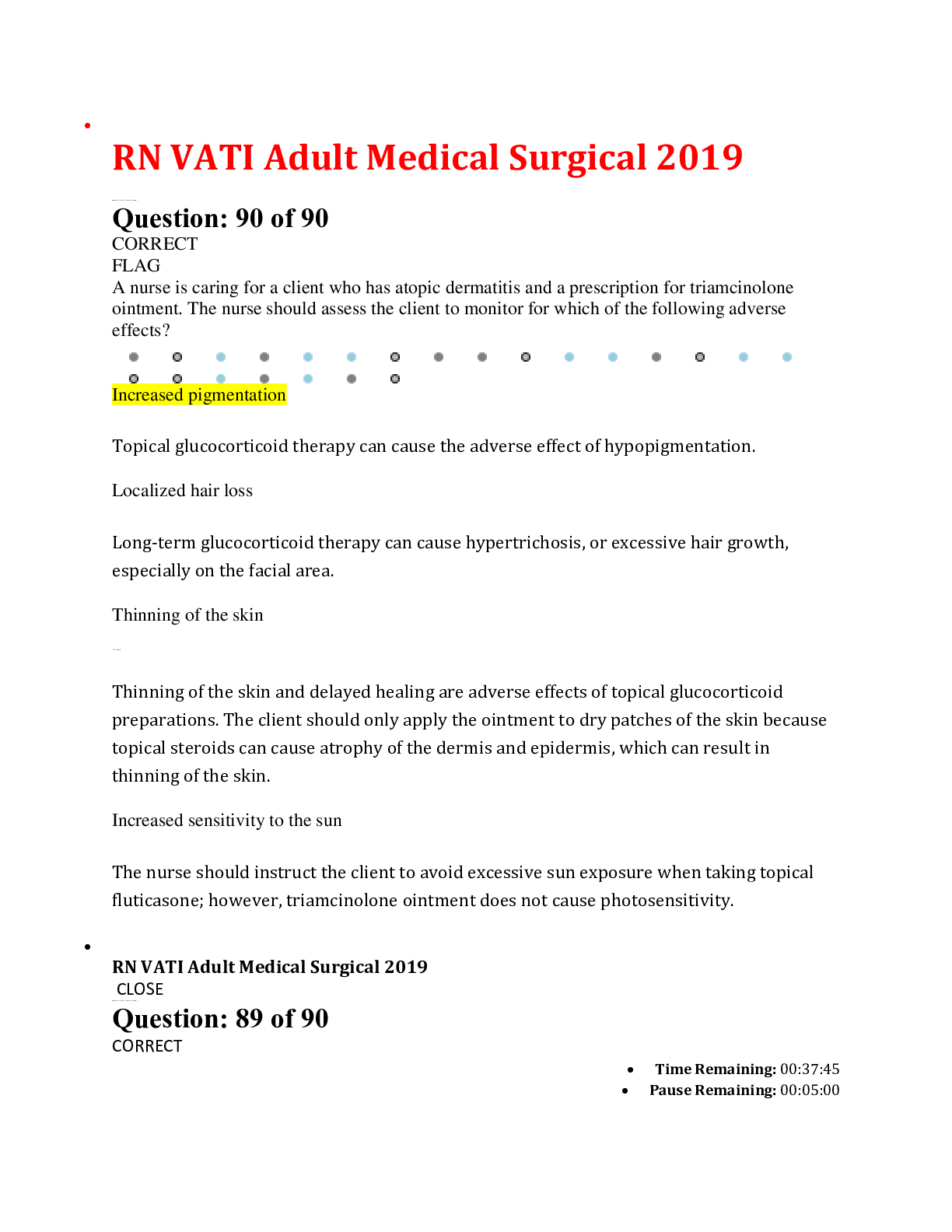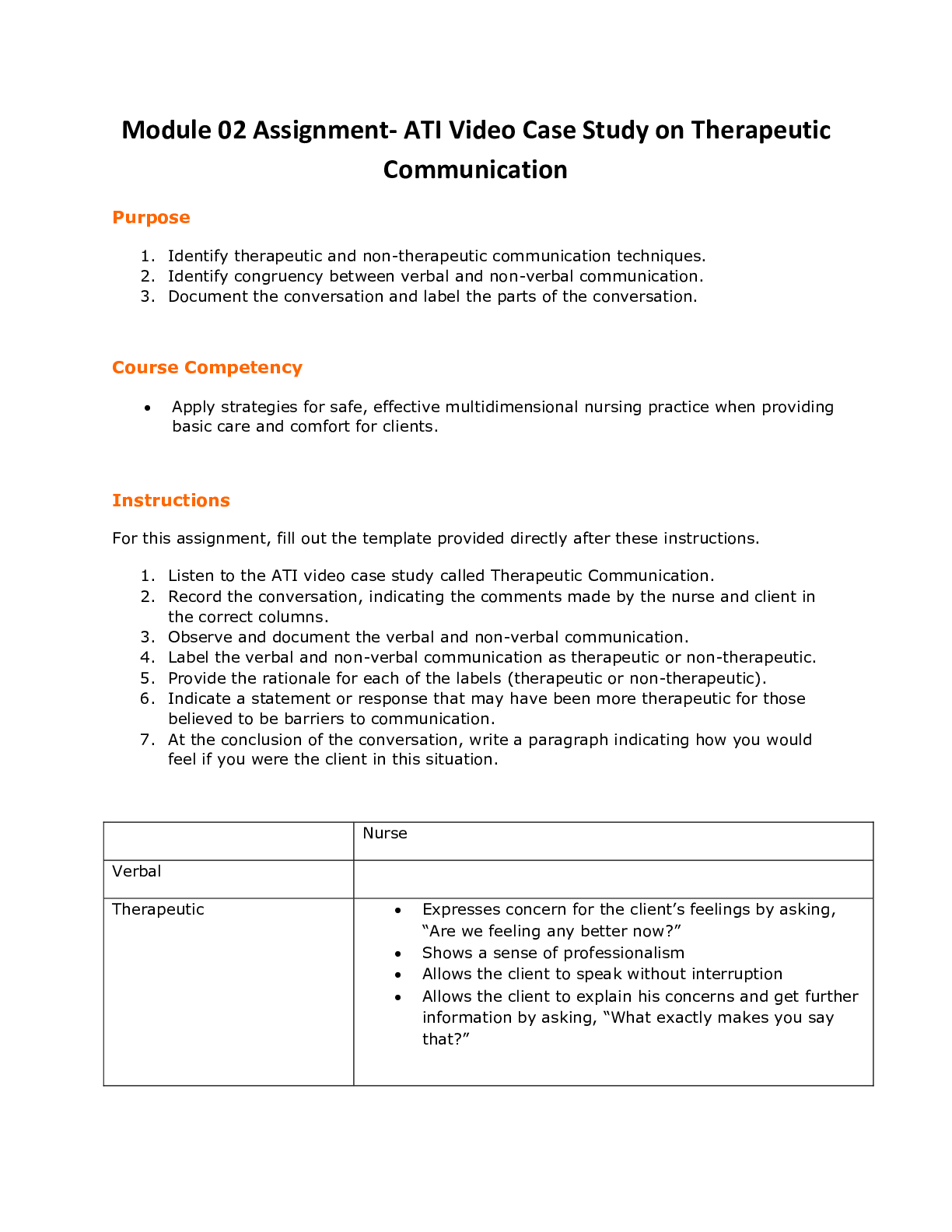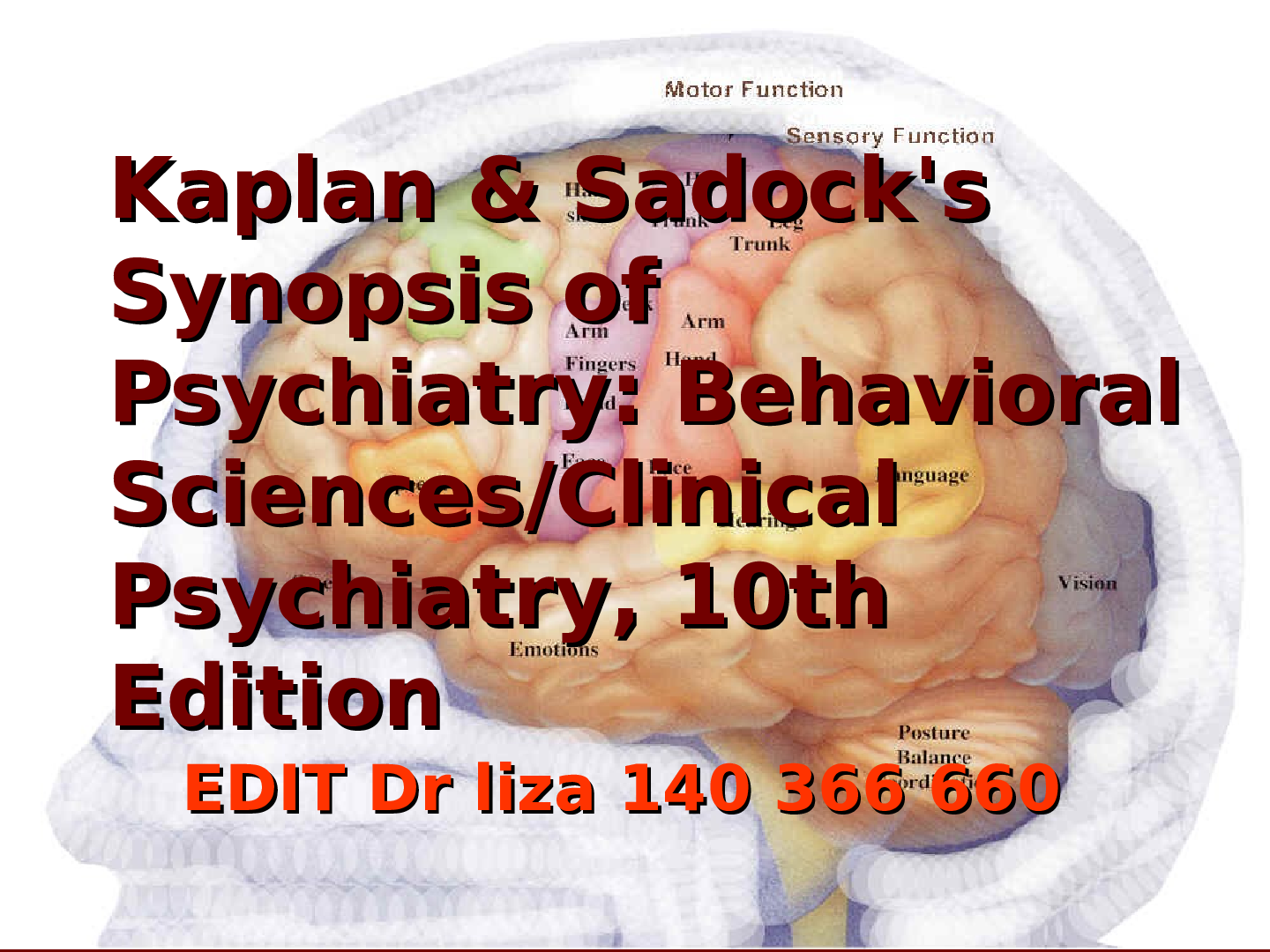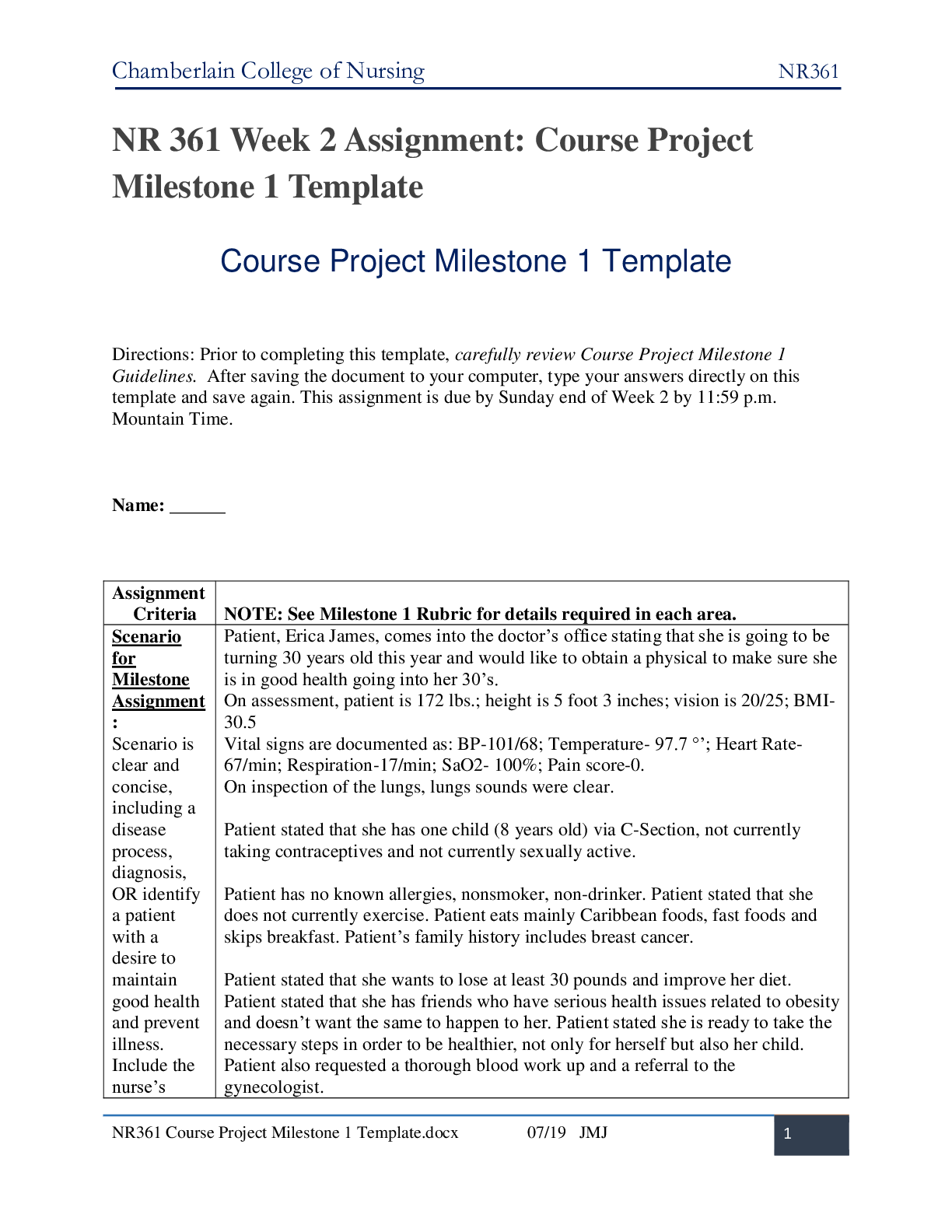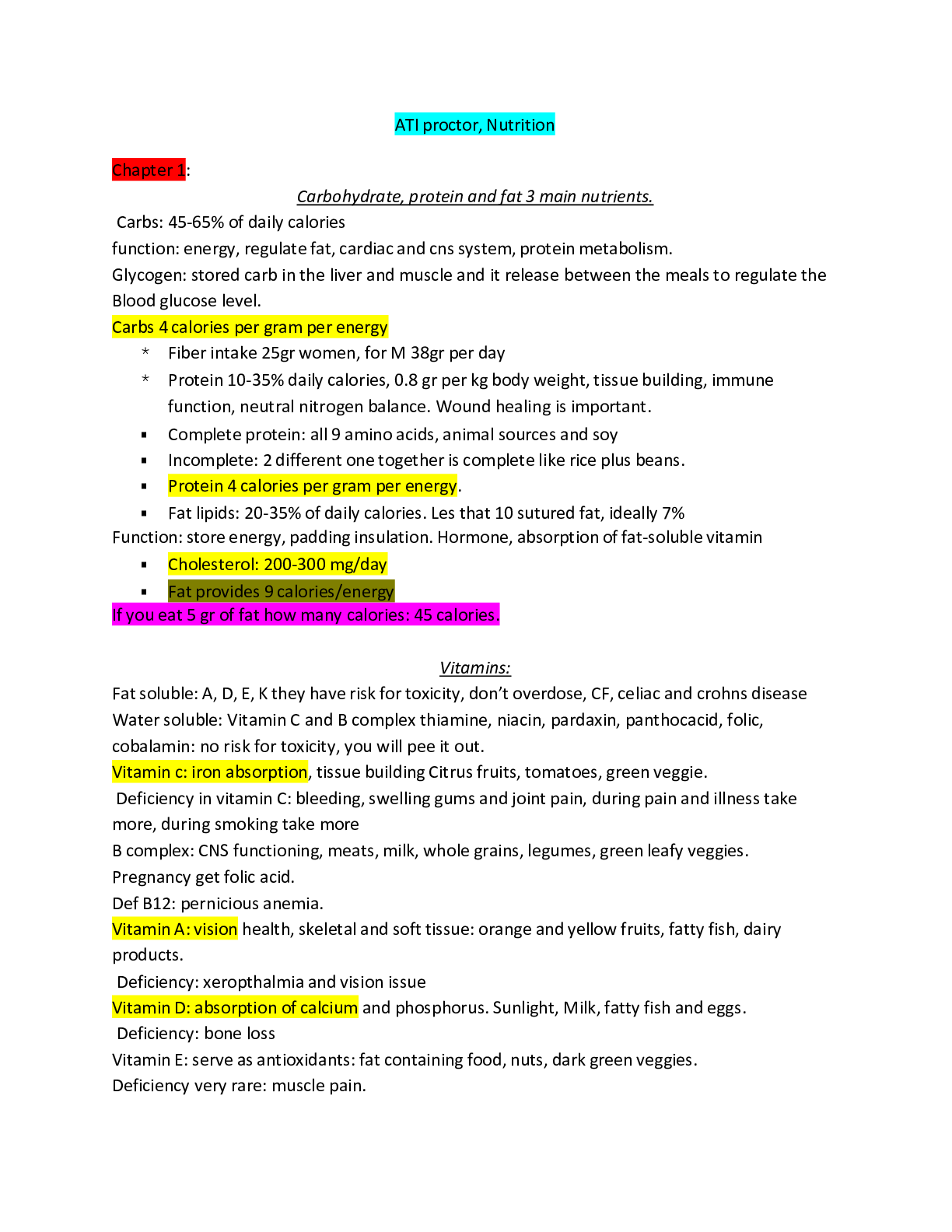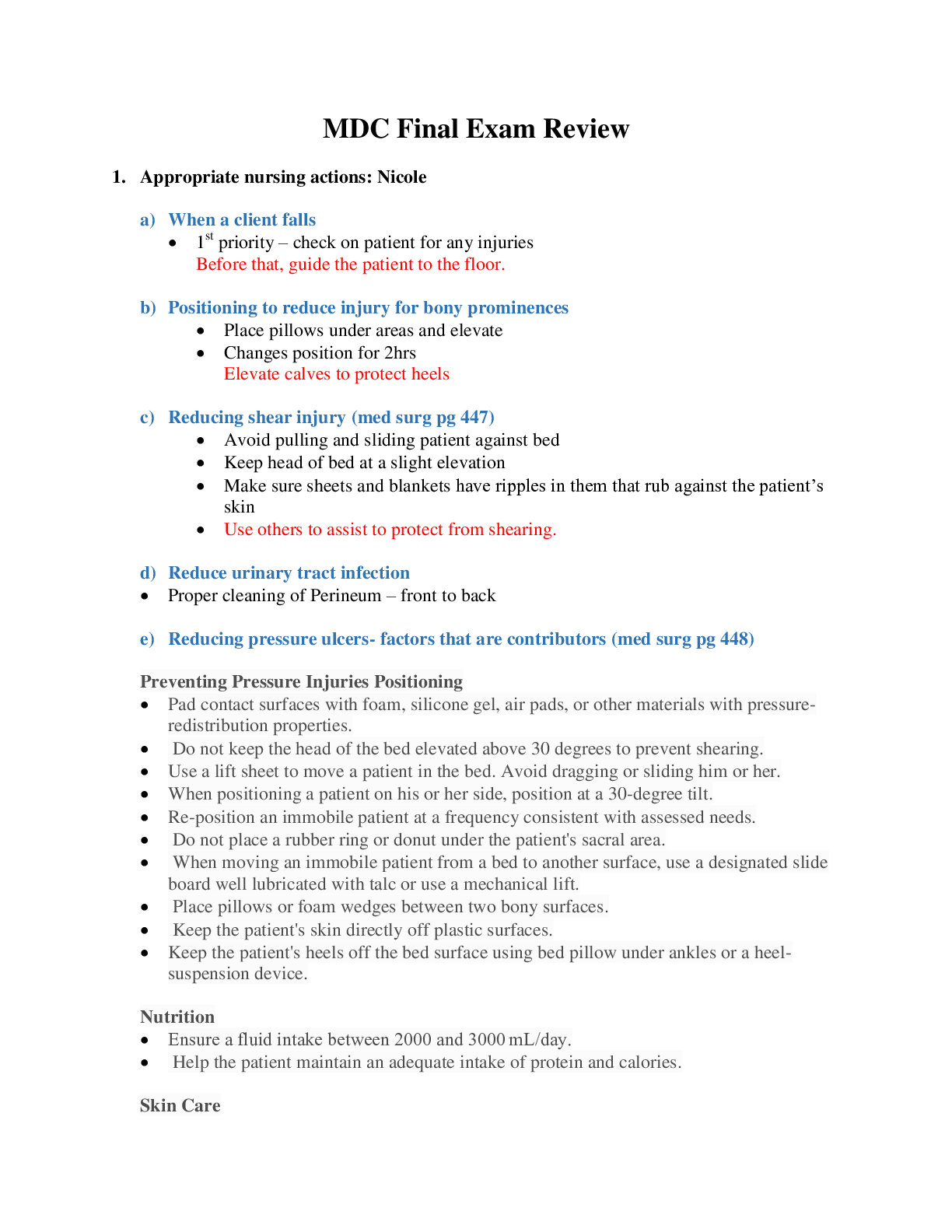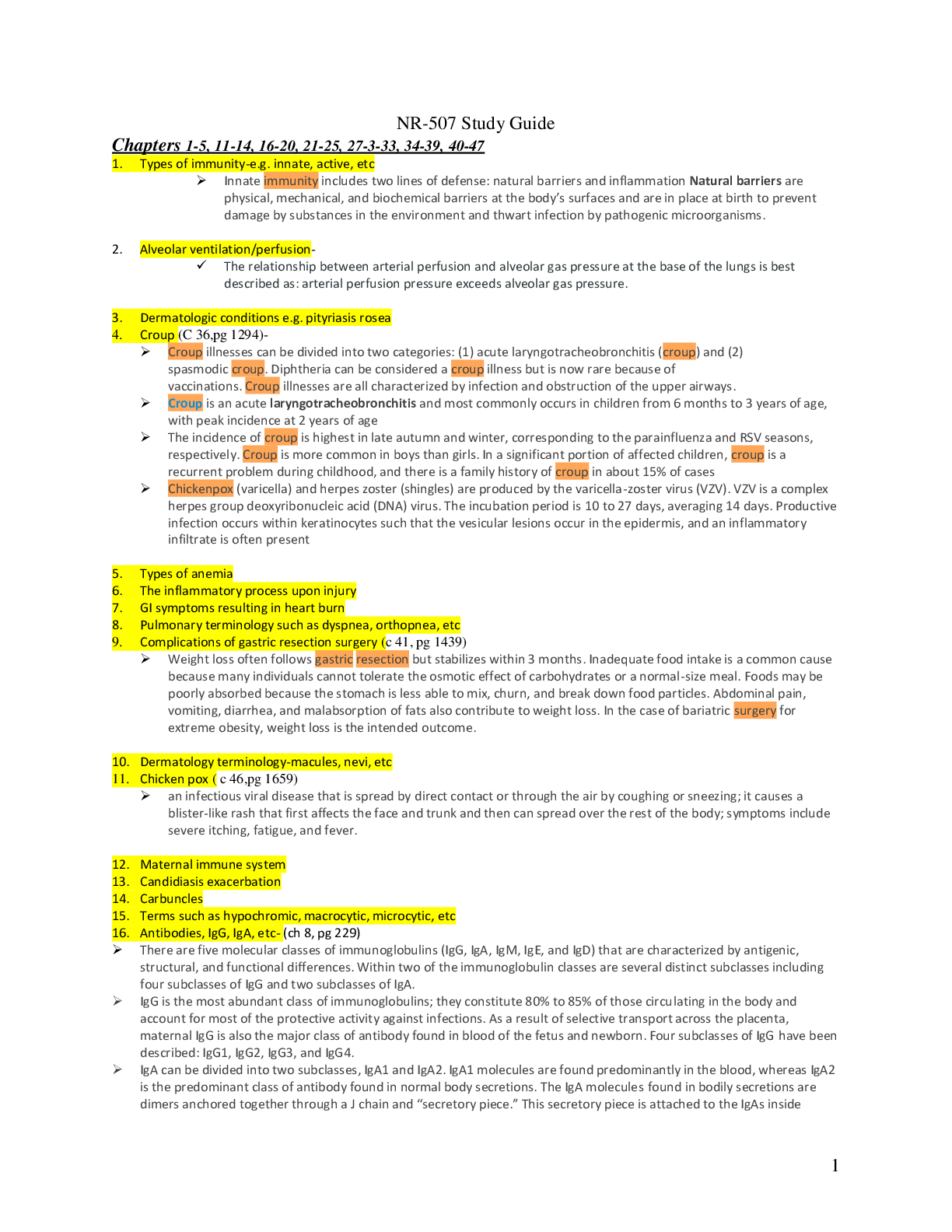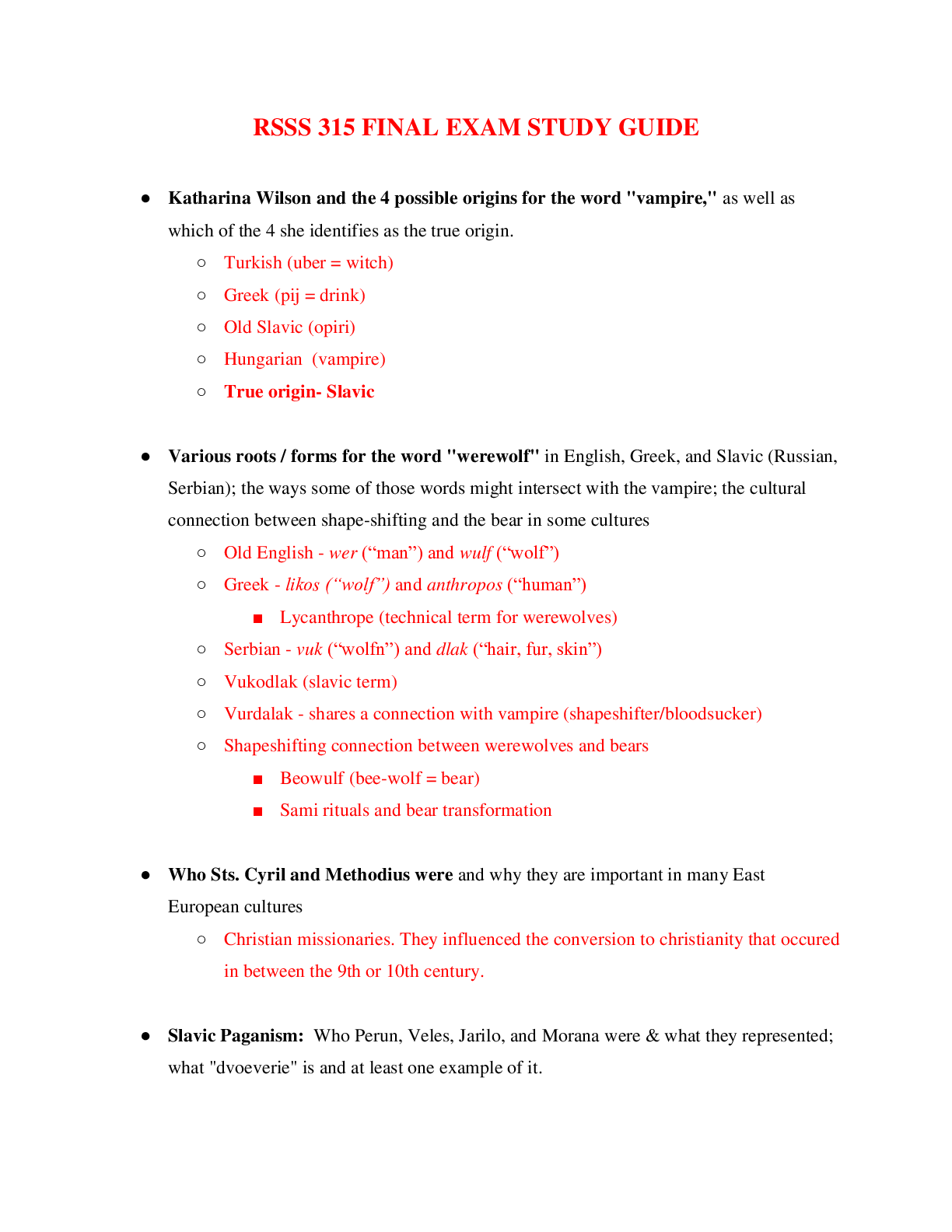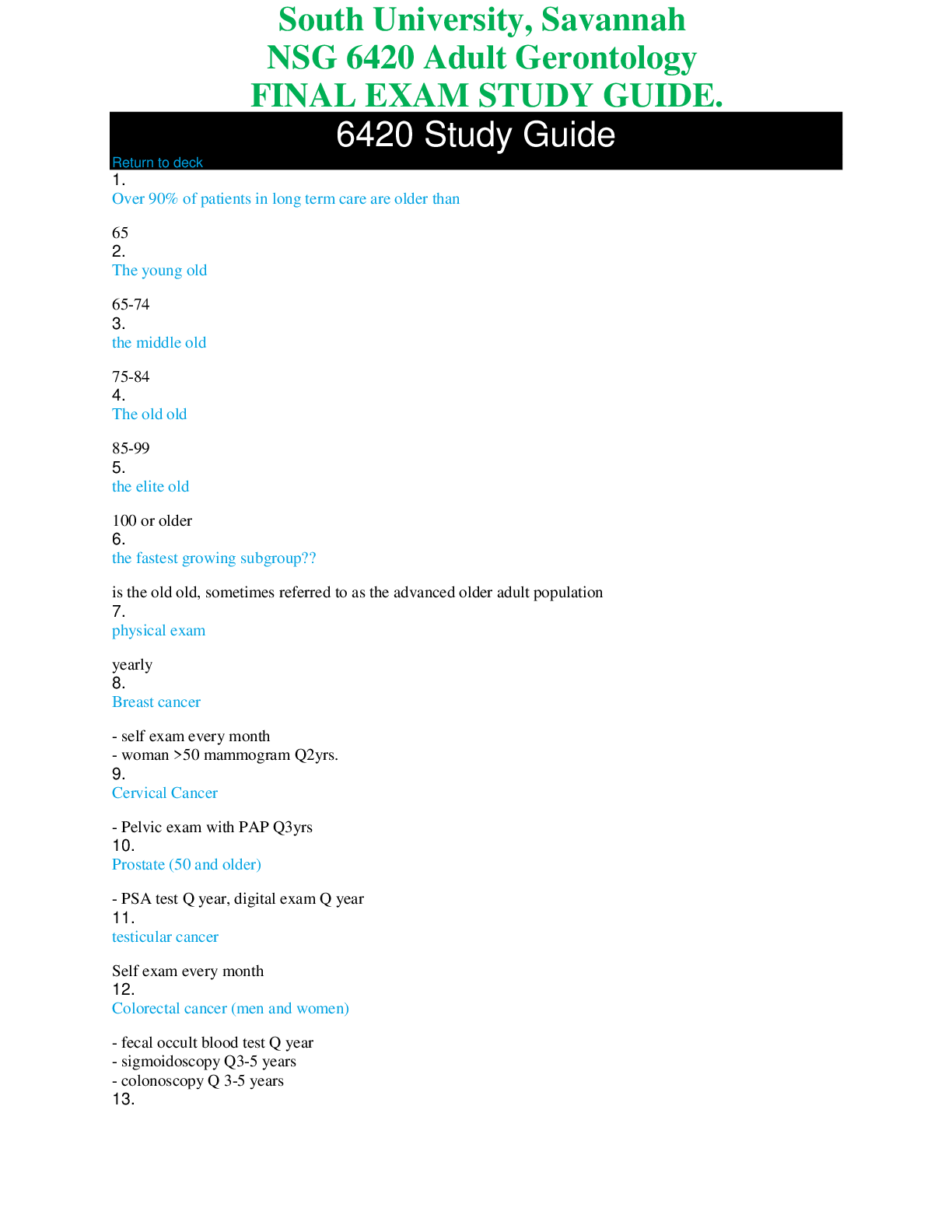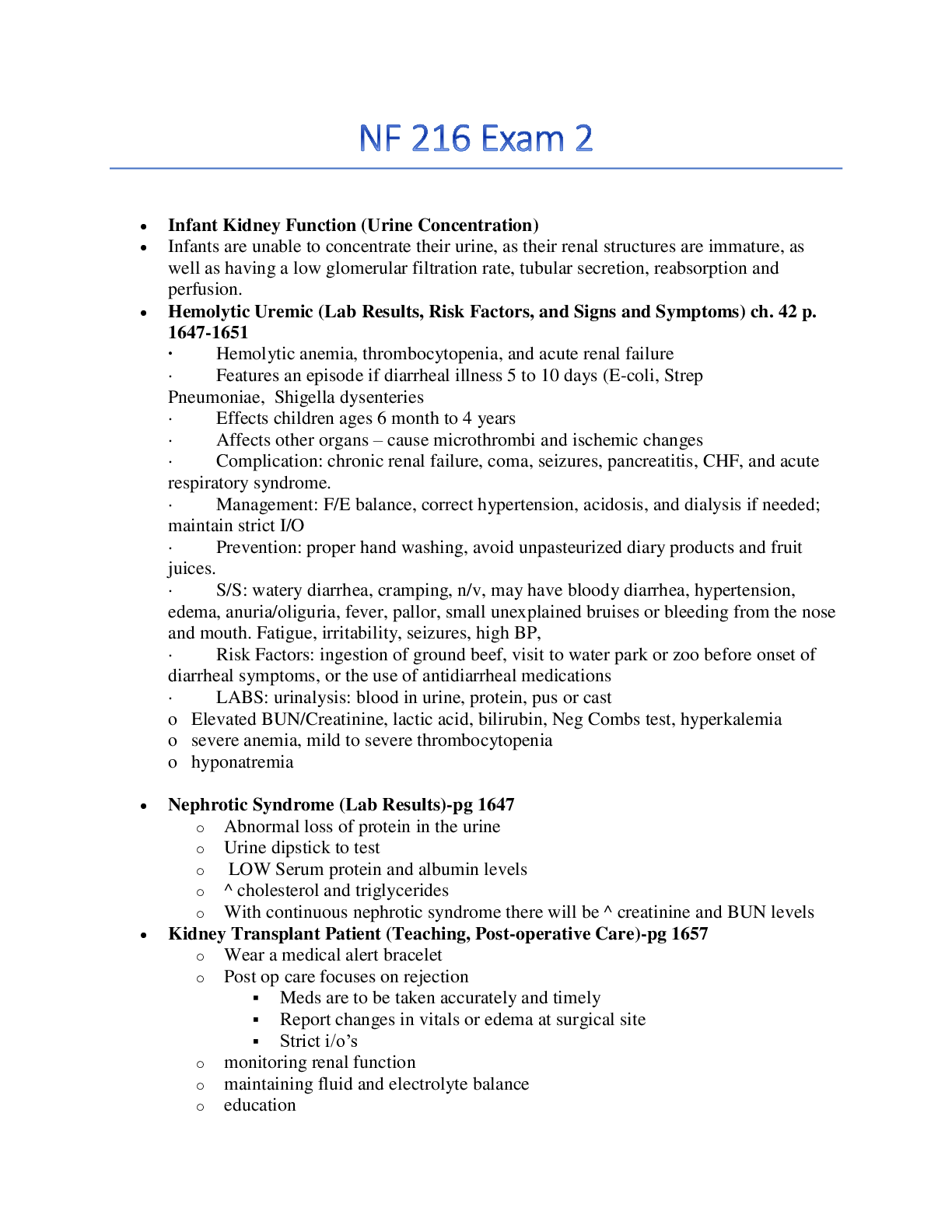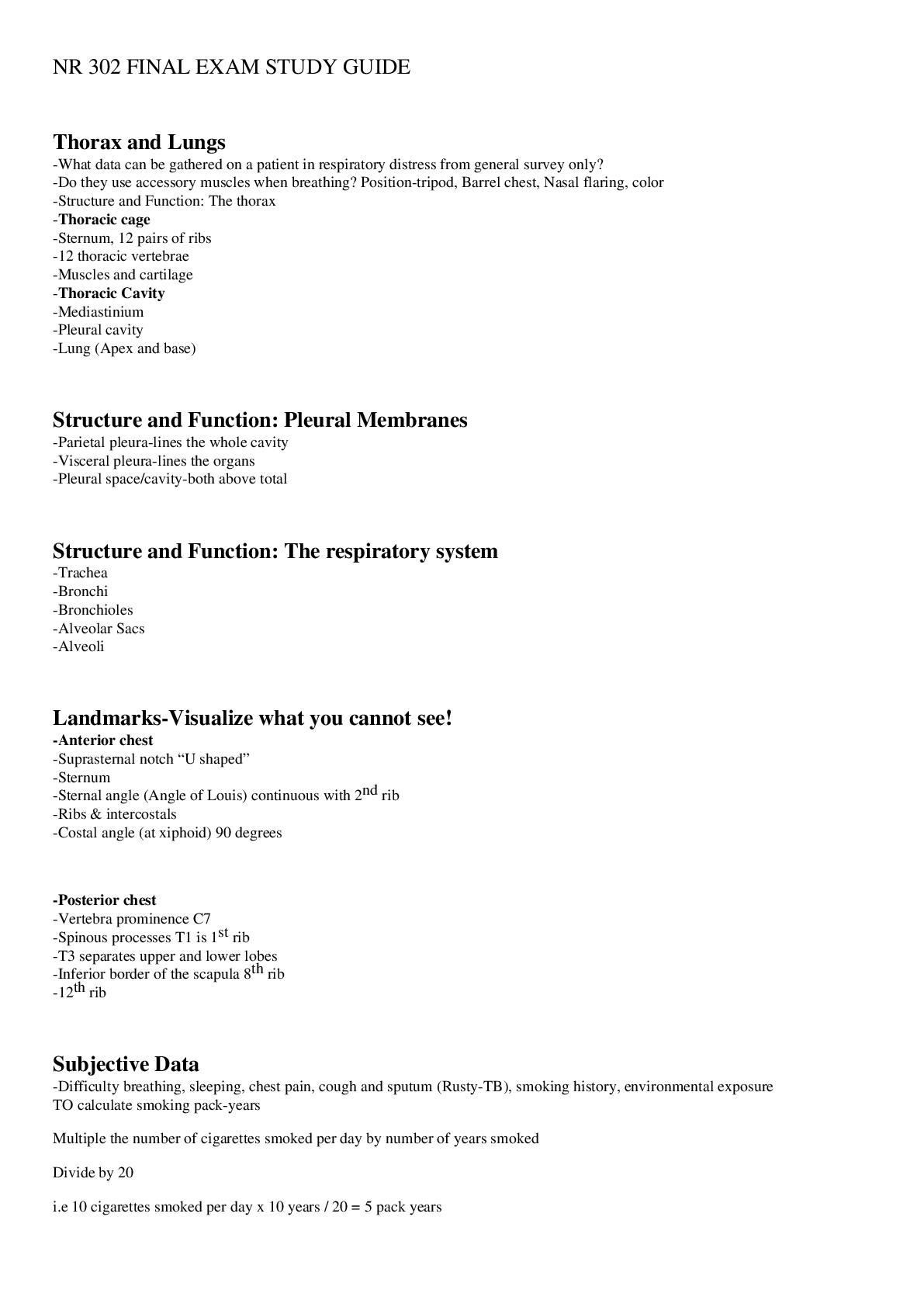*NURSING > STUDY GUIDE > NUR 2092 Final Exam Study Guide All Week 1 -11 Tests (All)
NUR 2092 Final Exam Study Guide All Week 1 -11 Tests
Document Content and Description Below
NUR 2092 Final Exam Study Guide tests Quiz 1 1. In meeting the safety needs of the adolescent client, it would be most important for the nurse to focus her teaching on: A. Smoking B. Sports injur... y C. Alcohol abuse D. Drivers education 2. When implementing the use of restraints on a hospitalized client the nurse should. a. Restrain all confused clients so they do not sustain a fall injury b. Tie restraint to bottom of the side rail so the client can’t reach c. Ensure that the primary care provider renews orders every 24 hours d. Release and provide skin assessment once every shift 3. A client on the hospital unit has fallen. Place the nursing interventions in order of priority: A. Identify all witnesses B. Call the physician C. Assess and provide urgent care D. Notify the charge nurse E. Fill out the incident report Correct order: C, D, B, A, E 4. A nurse observes smoke coming from under the door of the staff lounge. Which is the priority action? a. Extinguish b. Pull alarm c. Evacuate the patient d. Close all open doors on the unit 5 A nurse manager is renewing guidelines to prevent injury with staff nurses. Which of the following should the nurse manager include in the teaching? (Select all that apply) A. Request assistance when repositioning a client B. Avoid a twisting, jerking movement C. Keep the knees slightly lower D. Use smooth movements E. Take a break from negative movements every 2-3 hours to flex and stretch joints and muscles Quiz 2 1. The physical assessment technology used during the musculoskeletal assessment include: 1. Palpation, interview, and auscultation 2. Inspection, palpation, and range of motion 3. Observation, palpation, and auscultation 4. Interview, percussion, and palpation 2) A 50-year-old woman had a surgical repair of a fracture of her right tibia 2 days ago. She has been using crutches for ambulation and must remain non-weight bearing on her right leg but must learn to use the steps leading into her house. The nurse should instruct the woman to - Lead with the left leg when going up the steps, and lead with the right leg when going down the steps 3) A client is newly diagnosed with osteoarthritis of her knees and she has told the nurse that the healthcare provider prescribed acetaminophen and ibuprofen for pain. Client says she can not afford prescription. The nurse's best response would be. a. Dr. Cho thinks your pain is only minimal and the cheap medications are a good way to keep you out of the office. b. Dr. Cho knows that these medications will help your pain and they are relatively inexpensive and available over the counter at your local grocery store or pharmacy c. I’ll call the social worker d. Dr. Cho knows that these medications are covered by your insurance and you shouldn’t be worried 4) In assessing a client who has been immobilized because of illness, the nurse would most likely document the client’s muscles as which of the following? - Atrophied 5) A nurse is performing health screenings of client’s as a health fair. Which of the following clients are at risk for osteoporosis? (Select all that apply) - A 40-year-old client who takes prednisone for asthma - A 45-year-old client who takes Dilantin for seizures - A 65-year-old client who has a sedentary lifestyle - A 70-year-old client who has smoked for 50 years CLASS NOTED 04-16-18 Osteomalacia—softening of bone---Paget’s disease: affects skull, vertebrae..painful (Tx PAIN)—Osteomyelitis: infection of bone, long term ABT, PICC/CENTRAL 6ks to months, painful—Tumors: malignant: primary: 10-30 age secondary: metastatic: occurs in older adults, metastasized; Osteosarcoma=death—Osteoporosis: most common in postmenopausal women, Ca loss, reduction of weight bearing activities, decreased estrogen level, loss of bone density; silent disease; bone mineral density test; 65 yrs and older; first sign in fx back, wrist, hip; vertebrae become compact (lose ht); supplements (Fosamax, Boniva)-review Fosamax; may develop kyphosis, COPD,--fibromyalgia: nerve pain, pain stiffness in lower back, chest, exacerbation and remissions; lack of sleep stress, not eating right, arthritis, worsen with increased activity, hot and cold weather, diff altitudes, migraine common symptom, bright light, noise; prevent: restful night sleep, limit stress, eat well, TX with anti inflammatory, Elavil, Cymbalta, gabapentin, lyrica---Gout deposits in joints, uric acid—primary error in purine levels, common in men—secondary excessive uric acid in blood any age, medications: diuretics, renal insufficiency, crash diet, chemo drugs—Allopurinol: acute, maintenance, and for kidney stones—exacerbation of gout: Colchicine—low purine diet: red & organ meat, shellfish, alcohol, gravies, strong cheeses (pg 331)---Osteoarthritis: DJD-obesity, wear and tear, aging; usually single joint; weight bearing joints; NSAIDS, lidocaine patches—rheumatoid arthritis: bilateral joints—arthroplasty joint surgery—arthroscopy: look at joint—Pg 308—osteoarthritis: Mobic or Celebrex—RA: synovial, autoimmune, exacerbation, upper extremities, bilateral or symmetrical, immunosuppressants, methotrexate, steroids, stiffness in joints, weak, assistive device to eat, ADLs; exacerbation and remission—Lyme disease: trick, pain, bullseye rash, flu like symptoms (doxycycline early)—dyspnea, dizziness, palpitations, bell's palsy, dysrhythmias (abt at least 30 days-late) EXAM notes Sentinel event = loss of life or limb Look alike/Sound alike medications (Use TallMan lettering) Sharp end (Active error) direct patient care - pt fell and didn’t do a fall assessment. Amputated wrong leg, no bed alarm. Blunt end (Latent error)… documented on the wrong pt SBAR: one nurse to another, facility, collaboration. Least invasive to most invasive: Family member to remain with the client, bed alarm, nurses station, *make sure they have their call bell*, OD at the home - Call poison control RACE: rescue, alarm, contain, extinguish. PASS: pull, aim, sweep, spray. Joint commissions: voice concerns, advocate for themselves. Just culture/Culture of safety: Done with communication and root-cause analysis Home safety - alarms (Carbon dioxide and fire), monitors, cabinet locks Car seat: middle back rear facing till age 2 (Booster seat in middle of back seat, stay in the back seat until age 13 and must wear seat belt) Food poisoning - hand hygiene, proper handling, eating out safety, proper storage, store raw food at the very bottom. Immunocompromised caution with raw foods and unpasteurized milk Elderly adult: clutter, rugs, cords, anything that can catch on fire, pets. Calcium and Phosphorus normal levels (Need to know) Calcium - 8.5-10.5mg/dL, Phosphorus - 2.7-4.5 mg/dL Know difference between RA and Osteoporosis Celebrex, mobic, allopurinol, coltrazine (Know these meds) Medications that increase risk for falls: Narcotics, Diuretics, Anti-anxiety, Anti-psychotics Preventing falls in adults - Keep active *Basic Nursing Book Chapter 23 (safety)* Most at risk for age group pg 653 (basic nursing safety chapter) • Most at risk for suffocation: Newborns and infants • Most at risk for accidental injury, drowning, and poisoning: Toddlers • Most at risk for SI and HI: Adolescents • Most at risk for falls, burns, pedestrian and motor vehicle accidents(crashes): Older Adults • Most at risk for motor vehicle accidents (crashes): Middle Adults Padding, helmet, knee pads, cord near crib, falling dressers. Calcium and Vitamin D for healthy bones. Know low purine diet (Foods you should not eat with Gout) • Alcohol • Fish • Cured meats 90% of hip fractures happen due to falls Client at the hospital is risk for falls, you should • Clear clutter • Teach to use call bell • Illuminate pathway • Move them closer to the nurses station • Have someone stay with them • Encourage regular exercise (Weight bearing) • Proper footwear (Non-skid socks) • Assess for LOC, risk for falls/injury Client at home is risk for falls, you should teach • Client to know surroundings (placement of furniture) • Remove throw rugs • Rails (bars) in the restroom • Shower chair (seat in shower) • Raise toilet seat • Electrical cords behind furniture • Proper lighting • Proper shoes • Bed in lowest position • Clear pathways (remove all clutter) Client needs restraints, what should you do: • Obtain an order • Chart every hr • Remove restraints every hour (assess skin, circulation, repositioning (aid can do)) • Offer food, water, bathroom • Must use quick release knot and two finger space The Rights of Medication: • Patient • Medication • Dose • Route • Time • Documentation • Education • Assessment • Evaluation • Refusal • Expiration date • Reason response Complete components of an order: • Generic name • Brand name (When applicable) • Metric dose (Strength) • Frequency • Duration • Route • Indication Order of steps when a nurse makes a medication error: • Assess the patient • Call health provider • Notify manager • Complete incident report EXAM #2 Notes and quizzes WEEK 4 QUIZ 1. A client with renal calculi is advised to restrict calcium i the diet. The nurse determines that the client understands the restrictions when the client states to avoid which types of food? a. chicken, beef, and salmon b. Green vegetables, fruits, and legumes c. chocolate, smoked fish, and beans d. Eggs, meat, and poultry 2. The client returning from a colonoscopy has been given a diagnosis of crohn’s disease. The oncoming shift nurse expects to note which manifestation in the client? Select all that apply a. Steatorrhea (fatty stools) b. Firm, rigid abdomen c. Constipation d. Enlarged hemorrhoids e. diarrhea 3. The nurses teaching strategies for clients who have IBS(irritable bowel syndrome) should focus on: a. Lifestyle changes b. Bowel hygiene c. Dietary modification d. Response to medications 4. The nurse is performing discharge teaching for a client admitted with pyelonephritis. The client asks the nurse, “what is pyelonephritis?” based on the nurse’s knowledge, the best response would be: a. Inflammation of the bladder b. Rupture of the bladder c. Infection of the kidney- need for antibiotics d. Infection of the lower urinary tract 5. A nurse in a provider's office is assessing a client who reports losing control of urine whenever she coughs, laughs, or sneezes. The client relates a history of three vaginal births, but no serious accidents or illness. Which of the following interventions are appropriate for helping to control or eliminate the client’s incontinence? (Select all that apply) a. Limit total daily fluid intake b. Decrease or avoid caffeine c. Increase the intake of calcium supplements d. Avoid the intake of alcohol e. Use Crede maneuver (when the bladder is manipulated to expel urine). Cuday cath is for pt with an enlarged prostate External wicking cath - purewick WEEK 5 QUIZ 1. A client asks why a diagnosis has been ordered and the nurse replies. “I’, not sure, but will find out for you.” When the nurse returns later and provides the explanation, the nurse is acting under which principle? a. Nonmaleficence b. Veracity c. Beneficence d. Fidelity 2. Examples of EBP may include: a. Strict adherence to written procedures b. Checking with a healthcare provider about how to carry out an order c. Securing the client's preference about the care being provided d. Accessing an evidence summary 3. Client have the right to refuse medically necessary treatment: a. If they have been evaluated by a psychiatrist b. If they have decisional capacity c. For minor treatment treatments only d. After the rest of kin has been notified 4. A nurse on a medical-surgical unit has received change-of-shift report and will care for four clients. Which of the following clients needs may the nurse assign to an assistive personnel (AP)? a. Feeding a client who was admitted 24 hr ago with aspiration pneumonia b. Reinforcing teaching with a client who is learning to walk using a quad cane c. Reapplying a condom catheter for a clients who has urinary incontinence d. Applying a sterile dressing to a pressure ulcer 5. A client is referred to a surgeon by the healthcare provider. After meeting the surgeon, the client decides to consult with a different surgeon about treatment options. The nurse supports the client’s action utilizing which ethical principle? a. Beneficence b. Veracity c. Autonomy d. Fidelity NOTES FROM WEEK 5 SLIDES NEEDED FOR TEST ADPIE - Assessment, Diagnosis, Planning, Implementation and Evaluation EMTALA - The Emergency Medical Treatment and Labor Act HIPAA - Health Insurance Portability and Accountability Act PDSA - Plan it, Do it, Study it and Act KSA’S - Knowledge, Skills and Attitudes QSEN - Quality and Safety Education for Nurses WEEK 6 QUIZ 1. Which clients are at the greatest risk for instability during the time of surgery? Select all that apply. 1. 96 year old retired person who will have repair of a right foot bunion (Bc of age) 2. 61 year old patient with a history of hypertension that is well controlled with medications 3. 23 yo who is 5’6” and 125 lbs 4. 30 yo cancer pt who is mildly immunosuppressed following a recent round of chemo (High risk of infection) 5. 56 yo pt c a 10 year hx of emphysema (Airway) 2. What are the clinical manifestations of MH? a. Decreased body temperature and decreased CO2 b. Increased body temperature and elevated CO2 c. Flushed skin tone and flaccid masseter muscle d. Mottling skin and masseter muscle spasm e. Tachycardia and decrease in O2 f. Bradycardia and increase in O2 3. Following major abdominal surgery when should the discharge client definitely call the hcp? Select all that apply. A. Oral temp of 38.8 c B. Persistent weakness and fatigue C. Change in mental status D. Decreased appetite E. Nothing that incisional pain feels worse just prior to bedtime 4. The following activities are performed in various perioperative phases. Identify the correct perioperative phases for each activity listed below. You may use each perioperative phase more than once. Preoperative (A); Intraoperative (B); Postoperative (C) a. Pt teaching = a,c b. Airway management = b,c c. Frequent vital signs = b,c d. Maintain sterile field = b e. Obtaining informed consent = a f. Skin assessment = a (What did the client come in with), b (Repositioning), c (Incision) g. Admin of sedative agents = a,b COCA = color, odor, consistency, and amount (drainage) SOME KEY POINTS FOR EXAM 2 HibiClens - Decreases the bacteria on the skin Know signs and symptoms and treatment for malignant hypothermia IV site, what meds are given, Vanco for MRSA Inpatient a. They have a ride b. 24 hour care Outpatient a. When to call the doctor b. s/s Exam 2 review • s/s of pyelonephritis o Flank, back, or pelvis pain o Uti o Chills, fever, fatigue, loss of appetite or malaise o Nausea and/or vomiting o Elevated heart rate • s/s of uti o Cloudy urine o Foul smell o Frequent urge to urinate o Pain or burning sensation when urinating o Blood in the urine • s/s of glomerulonephritis o Pink or cola colored urine from RBC in the urine o Foamy urine due to excess protein o High BP o Fluid retention (Edema) with swelling evident in the face, hands, feet and abdomen • Different types of incontinence o Transient Acute Usually caused by treatable factors (Infection, Confusion, Medication treatment) • Stress Involuntary loss of urine due to increase in intra abdominal pressure Usually does not occur in the supine position Can happen when coughing, sneezing, laughing and physical activity Can be caused by childbirth, menopause, obesity and straining from chronic constipation • Urge The involuntary loss of urine that occurs soon after feeling an urgent need to void Loss of urine before reaching the toilet with an inability to suppress the need to void • Mixed Indication of loss of urine with features of 2 or more types of incontinence • Overflow Involuntary loss of urine due to an overflow of a distended bladder • Functional Loss of urine due to inability to reach the toilet because of environmental barriers, physical limitations, loss of memory, disorientation • Reflex Experiencing the emptying of the bladder without the sensation of the need to void Usually seen with spinal cord injuries • Total Continuous and unpredictable loss of urine resulting from a surgery, trauma, or physical malformation Anatomic abnormality • Lasix • Also known as FUROSEMIDE • Antihypertensive, loop or high ceiling type diuretic • Treats acute edema with liver cirrhosis, renal impairment, of HF • Prevents the reabsorption of sodium and chloride by blocking thr symporter in the loop of helena • Can be given PO, IV, IM • ADVERSE EFFECTS: Dehydration, electrolyte imbalance (causes dysrhythmias), dizziness and syncope (HTN), metabolic alkalosis, profound diuresis (excessive amount) • CONTRAINDICATION: Sulfa allergy, coma, dehydration, electrolyte imbalance or depletion • DRUG INTERACTIONS: Digoxin (decrease K+, increase effectiveness), Lithium (toxicity), alcohol (additional diuretic action) • Kidney stones (most common) • 24 hr urine • Get rid of the first urine • Put sign above bed that 24 hour urine is being collected • EVERYTHING IS KEPT ON ICE (Catheter bag, jug, urinal) • Review informed consent • Nurse is only there as a witness • It is the PHYSICIANS responsibility to explain the procedure to the client • Know slide of laws (Slide from week 5) • BILL OF RIGHTS: 10 amendments to the US constitution • SOCIAL SECURITY ACT 1965: Medicare • COBRA: Temp extension of employer health insurance after termination • EMTALA 1986: Client must be stabilized regardless of insurance status • ADA: Provides protection against discrimination of individuals with disabilities • PSDA 1991: Informed consent • HIPAA 1996: Nurses and other healthcare providers must protects the client’s right to privacy. CANNOT share information with unauthorized individuals. • 30 mL/hr urine output • Palliative and curative surgeries (Know the difference) • Fidelity, nonmaleficence…. ECT… (Know these terms) • AUTONOMY: Respecting the client's decisions about their health (Non judgement) • NONMALEFICENCE: Do no harm • BENEFICENCE: Promote the client’s best interest (Advocate) • FIDELITY: loyalty (Doing what you say you are going to do, when you said you would do it) • VERACITY: Telling the truth (Accuracy, someone’s character) • JUSTICE: Giving medical benefits fairly (Treating someone no matter their insurance status) • DEFAMATION: False communication to a third party person • SLANDER: Oral defamatory statements • LIBEL: Written defamatory statements • PATERNALISM: Power over the client (Healthcare professionals make decisions about clients healthcare) Example: Dr decides not to reveal a cancer diagnosis after client says he would kill himself if he had cancer • UTILITARIANISM: Principle theory supports what is best for the most people (Also creates the most happiness for the most people) Example: Using resources to help many people rather than using all resources to help one critical person) • DEONTOLOGY: Principle theory judges the morality of an action based on the action’s adherence to rules (Example: We do not use restraints on older clients. Restraining someone against their will could not be considered a universal law) • Preop: prep your pt.. “ON call” meds for the OR • Know about quality improvement • Know S/S of bowel obstructions • Nausea and vomiting (Can vomit stool) • Constipation • Abdominal pain • Anorexia • Tachycardia, hypotension • Abdominal distention (swallowing air and intestinal secretions due to hyperactivity) • Tympanitic abdominal • Empty rectum • Preop meds within an hour • Antibiotics • Treatment of MH (malignant hyperthermia) and s/s • Acute, life-threatening complication • Begins with skeletal muscle exposed to specific agent • Causes increased metabolism, calcium levels in muscle cells • Leads to acidosis, high temperatures, dysrhythmia • Manifestations: tachycardia, skin mottling, cyanosis, myoglobinuria, rise in end tidal carbon dioxide, elevated temperature • Different devices for blood transfusions • Competent care, ethical consideration (review) • Moral distress occurs when you are unable to act upon what you believe is the appropriate action to take or when you otherwise act in a manner contrary to your personal and professional values • 5 most frequent ethical issues for nurses: 1. Protecting clients rights and human dignity 2. Respecting/not respecting informed consent to treatment 3. Providing care with possible risk to the nurse’s health 4. Using/not using physical or chemical restraints 5. Working with staffing patterns that limit patient access to nursing care • ETHICAL GUIDANCE AND CONFLICT: Health care policy, health care law and health care economics • ETHICAL PRACTICE: Professionalism • ETHICAL OBLIGATIONS: Quality, safety, evidence, collaboration, technology and informatics, leadership • Education for a postoperative client (education for prevention of complications) • DVT medication • Breathing (spirometer) • Fall precautions • Review stoma information (Look, devises, etc) • Peristomal skin is the skin around the stoma. Call Dr. if skin is blue/purple. Black means loss of blood flow (Necrotic) • Effluent fluid (Ileostomy - higher in the bowel) • Wafer last 2-4 days • Do not change the wafer after meals, wait 2-3 hrs (Constant production of stool) • Clean peristomal skin, not the stoma (DO NOT use soap) • Charcoal tablet for odor control • Excoriated skin is wet • Caking technique (done by WOCN) used to help better adhesive grip with wafer • Prolapsed stoma - is not emergent if it continues to produce stool (looks like an elephant trunk) • Risk for falls - frequent trips to the bathroom • Changes in social and intimate relationships • Understand skin sight prep for surgery o Antiseptic solutions with shower, removal of hair (Do not shave - clip) 1st step in reduction of infection • Surgical care improvement project (Review) o SCIP-1: Pre-op antibiotic given within 1 hr before incision o SCIP-2: Must receive SCIP recommended prophylactic antibiotic o SCIP-3: Discontinue antibiotic within 24 hrs of anestesia end time o SCIP-4: Controlled 6 am postoperative serum glucose (Cardiac only) o SCIP-6: Appropriate hair removal (Clip don’t shave) o SCIP-CARD-2: Perioperative beta-blocker therapy o SCIP-VTE-2: VTE prophylaxis within 24 hrs prior to or after anesthesia end time o SCIP-9: Remove urinary catheter by post op day 2 o SCIP-10: Temperature >96.8 F, 15 min after anesthesia end time • Electrolyte levels o Potassium 3.5-5.1 o calcium 8.5-10.5 o Sodium 135-145 o Magnesium 1.5-2.5 mg/dL 1.3-2.1mEq/dL Test 3 begins here. 05/14/18 Quiz 1 1. The nurse is reviewing the lab finding of a WBC count of 20,000. • Leukocytosis 2. A nurse is reviewing strategies to promote comfort with a client who has received immunization. Which of the following information should the patient be educated on? (select all that apply) a. Apply cool compress b. Tylenol or aspirin c. Use the extremity d. Apply a antimicrobial ointment e. Massage the injections site 3. An infant is admitted to the pediatric unit with a diagnosis of sepsis. The nurse is completing the nursing assessment, what is the priority of this assessment. a. Skin integrity b. Temp c. Jaundice d. Respiratory 4.When giving immunizations, which of the following assessment is not necessary? a. Allergy to eggs b. Family history of measles - not passed on to fetus c. History of past immunizations d. History of past illnesses. 5.Which of the following reactions indicates a medication allergy? a. GI bleed with aspirin - Adverse Rxn b. Nausea with azithromycin - SE c. Diarrhea with tegaserod - SE d. Angioedema with ramipril - Allergic rxn Know immunoglobulins P. 298 (iggy). Antibodies and immunoglobulins are same thing on her test. Slide 24 and 32. • IgA - found in respiratory and GI tract, also found in saliva, tears, mucous membranes (GI, urinary, reproductive, and respiratory tract), and colostrum to prevent from getting infection. • IgG - 75%, crosses placenta barrier, can carry out the job of the other Ig’s. Only one that can be given artificial donation infusion. Takes at least 10 days to be produced in response to and initial infection • IgM - 10-15% of the circulating antibody, Fight blood infections, located on b-cells, 1st antibodies produced by fetus. Always in our blood. Activates complement pathway. • IgD - on B-cells (Helps them work better). Present in the blood. Used as an anchor for antigens. • IgE - found in skin and mucous membranes. Responsible for allergy response and parasitic response (exaggerated immune response). Suppressed immune slide #31 • Primary immunodeficiency - 2 or more of the listed o 4 < ear infections within 12 months o 2 < sinus infections within 12 months o 2 < months taking antibiotics with little effect o 2 < pneumonia cases within 12 months o Failure to thrive o Recurrent deep skin or organ abscesses o Persistent thrush in mouth or fungal infection of skin o Need for IV antibiotics to clear infection o 2 < deep seated infections including septicemia • 2nd immunodeficiency o Other health problems develop for immunocompromised patients o Increases in incidences of infection by bacteria and viruses o Development of a supra-infection (MRSA, C-diff) o Development of treatment resistant fungal infection secondary to antibiotic treatment for primary bacterial infection DIFFERENT TYPES OF IMMUNITY • Natural and Artificial active o Natural (Body fights off a cold) o Artificial (vaccines) • Natural and Artificial passive o Natural (Passed from mom to baby) o Artificial (Transfusion of immunoglobulins / antibodies) IgG - only transfusion available • Innate immunity • Born with this immunity • Provides immediate protection • Visible symptoms • Humoral immunity • Body fights off the foreign body • Cell mediated immunity • The cells fight off the foreign body WBC, etc Natural killer cell (recognizes cancer) Immune cells Bone marrow Stem cells • RBCs Erythrocytes • WBCs Leukocytes Recognize and destroy foreign invaders Help with complement activation Stimulate the production of leukocytes in the bone marrow • If client gets a new kidney, they will need to continue to take anti rejection medications FOR LIFE • Cancer clients are immunosuppressed • Exaggerated immune response client would be an allergic reaction • Examples of responses Allergic reaction Cytotoxic reactions Autoimmune reactions Rheumatoid arthritis Systemic lupus erythematosus • Can be immunosuppressed and exaggerated at the same time • I have cancer. Given antibiotics and had a allergic response • Exaggerated immune response type 1 • Seasonal allergic rhinitis • Bee sting • Systemic anaphylactic reactions • Exaggerated immune response type 2 • Specific or cytotoxic • Autoimmune thrombocytopenic purpura • Graves disease • Autoimmune hemolytic anemia • Exaggerated immune response type 3 • immune complex mediated • Systemic lupus erythematosus • Exaggerated immune response type 4 • Cell-mediated or delayed hypersensitivity • Contact sensitivity to poison ivy and metals (jewelry) • Inflammation and infection • Inflammation does not automatically mean infection • Sprains and arthritis, heart attack, and muscle damage, blisters (Ex of inflammation without infection) • Things that end in -itis would be an example of inflammation due to infection (pancreatitis) • Allergic responses • Angioedema (Lisinopril) • Red watery eyes • Hives • Rash (Steven Johnson's) • SOB • GI upset • Swelling • Nasal congestion and sinus pressure • Speedy response is the cardinal principle • Recognize the s/s • Maintain a patent airway • Prevent spread of allergen by using a tourniquet when appropriate • Administer appropriate drugs • A nurse must place the pt in a in a recumbent position, elevate legs, keep the pt warm and support respirations with oxygen. BP must be maintained with IV fluids • Have the capacity to cause organ dysfunction • Lab tests • CRP • Detects inflammation • SED- “ESR” inflammatory response • ANA antinuclear antibody • Autoimmune disorders • RF rheumatoid factor • Allergy testing • CBC with differential • Shift to the left means Pt bone marrow cannot produce enough mature neutrophils to keep pace with the infection • Granulocytes (neutrophils) • Take 12 to 14 days to mature • The bands are less mature (Cannot fight infection) • The segs are more mature (Difficulty fighting infection) • Die in 12-18 hours • Eosinophils • Against parasites • Basophils • s/s on inflammation in allergic rxn • IgE • Macrophages • Immediate inflammatory responses GI tract • Destroy/ eliminate foreign invaders • Here for the duration • Large and picks up everything (Foreign bodies) • The five stages of inflammation • Swelling • Redness • Warmth • Pain • Decreased function • 1st part happens 24-28 hrs • Veins constrict • arteries dilate • Vascular stage of inflammation • Blood is going to rush to the area • Edema - attempting to protect the injury site • Hyperemia - increased blood flow • Capillary leak - swelling (the bodies way to make a cushion around the trauma) • 2nd stage cellular exudate • Warmth, redness, and pain • Purulent drainage/ pus (blister/ juicy zit) • Does not mean it is an infection • Like a mosquito/ ant bite • Digestion of the cells • 3rd stage tissue repair/ replacement • Scar tissue forms • Blood vessel growth returning to normal • Example - surgery - heal and have scar tissue • Turbo boost part of the innate immunity • Complement system • 20 different inactive plasma proteins • Part of innate immunity • What we are born with • 28 inactive • Acts as an enzyme • Enhances the cell action • Surrounds and sticks to the antigen • Brings the antigen to the antibody • Phagocytosis • 7 step process • Invasion (Got sneezed on) • Attraction (brings WBC in direct contact with the antigen) • Adherence (Sticks to the antigen and check the barcode) • Recognition (Knows that this is not part of the body- it’s an invader) • Cellular ingestion - “pacman” • Phagosome formation - attack ingested target • Degradation - digestion (How we get drainage and pus) • Antibody mediated immunity (AMI) • Produces B cells • Start as stem cells in the bone marrow • End up and stored in the spleen (where macro mature), tonsils, mucosa in the GI, and lymph nodes • Thymus - butterfly gland in the center of the chest • Antigen antibody interactions 1. Exposure 2. Antigen recognition 1. Macrophage and helper t cell present antigen b lymphocyte 3. Sensitization 1. “B cell” - sensitized to influenza a 4. Antibody production/ release 1. Plasma “effector” procedures 300 molecules antibody per second 5. Antibody antigen binding 1. WBC - neutralization/ destruction 6. Antibody binding actions 1. binds - deactivates takes power away 7. Sustainet immunity memory 1. Stays on reserve sometimes including organism does not result in illness 2. 2 lymph nodes 1. Plasma - “effector cell” produces antibodies 2. Memory - keeps on reserve for next exposure - Cell mediated immunity • Ability to differentiate self vs non self • Suppressor T cells help prevent • Helper and suppressor T cells must be balanced • To little helper T cell o suppressed and at risk for infection (Always sick) • Too many helper T cells o body will always be in an allergic reaction and overdrive • Cytotoxic T cells o kill parasites, protozoa, and virus cell • Memory T cells o are like the memory B cells • Natural killer cells - seeks and destroy o Most effective killing a virus o Tiny assassins o Pokes invader with an enzyme causing cell death WEEK 08 IN CLASS QUIZ 1. A nurse educator is reviewing with a newly hired nurse the difference in clinical manifestation of a localized versus a systemic infection, the nurse indicates understanding when she states that which of the following are clinical manifestations of a systemic infection? (Select all that apply) a. Fever b. Malaise c. Edema d. Pain or tenderness e. Increase in pulse and respiration rate 2. A baby is recovering from a thyroidectomy. The nurse realizes that the child is at risk for developing which of the following as an adult? ( select all that apply) • Increased inflammation • Infections • Increase in age-related chronic diseases • Autoimmune responses • Acute otitis media 3. The risk for infection can be best minimized by the nurse when initiating IV site by: • Appropriate site dressing • Gloving for the procedure • Proper vein site selection • Proper IV gauge selection • Effective topical skin preparation 4. A patient has tested positive for MRSA in the nares. The pt will be placed under which isolation precautions? • Standard precautions • Contact precautions • Airborne precautions • Droplet precautions IV LINES S/S Sepsis • B/P decreased • HR elevated • RR elevated • Urine output decreased (below 30 mL/Hr) Infiltration vs Phlebitis • Infiltration o Cool o Pale o Swollen o Painful o Cool to touch • Phlebitis o Warm o Red (Red streaks) o Swollen o Painful (Stop infusion and d/c the IV line) Pt states numbness and tingling at and below IV site - stop and d/c due to possibility of hitting a nerve • NUMBNESS/TINGLING = REMOVE THE IV • Wounds -> Pressure ulcers -> Braden Scale S/S inflammatory response • Edema • Erythema • Heat • Pain ** Fever 1st hallmark sign of infection** ** Elderly hallmark sign is confusion** o Localized (At the site) Edema Heat Pain Erythema • Systemic (System (Body) wide) Increase temp Increase wbc Fatigue reports Stages of infection • Incubation o Time of infection until manifestations of symptoms • Prodromal o Appearance of vague symptoms • Illness o Signs and symptoms present • Decline o Number of pathogen decreases • Convalescence o Tissue repair, return to health Risk factors • Very young • Very old • Uninsured • Residents of areas where an infection is prevalent Reduce risk • Hand hygiene • Clean site Increases risk • Smoking • Meds • multiple sex partners • Nursing/ medical procedures • Breaks in skin • Illness/ injury • Developmental stage Primary prevention • Reducing risk for injury and infection • Maintaining good hygiene • Properly using safety equipment • Proper food prep and maintenance 1. Pseudomonas 1. Interventions 1. Educate 2. Monitor renal fx 3. Sterile tech b. contact/ droplet (depending on location) 2. VRE (vancomycin resistant) . Interventions 1. Asses i&O 2. Assess Pain 3. Pt education 4. Administer medications a. Education 1. Wipe front to back b. Contact 1. *if present pt stays on lifetime precaution* 3. ESBL . Intervention a. Education 1. Do not share towels 2. clothing b. Contact 4. MRSA (methicillin resistant) . Interventions 1. Antibiotics 2. Lab 1. Peak and tough 2. Cbc 3. Rbc a. Education 1. Do not scratch b. Contact 1. Gloves and gown 5. C-diff (clostridium difficile) . Intervention 1. S/S cramping, dehydration, distinctive smell, loose watery stool 2. EIA Labs, cell toxicity, 3. Tx - iv fluids, vancomycin (po) 4. Monitor I&0s, electrolytes 5. Hand hygiene with soap and water a. Contact 1. Gloves and gown (on precaution up to a year after) 6. PN (pneumonia) . Intervention 1. Cbc, abg 2. Tx with antibiotics 3. Push fluids 4. Incentive spirometer a. standard 7. Tuberculosis (TB) . Intervention 1. Chest x-ray 2. Tx with multiple meds (Antibiotics) for a 6-9mo or longer 3. Compliance is usually an issues - Provide teaching a. Airborne 1. mask 8. HIV/AIDS . Intervention 1. Risk for infections 2. Balance nutrition 3. Hand hygiene 4. Combo of antivirals 5. Lifestyle teachings 6. Decreased WBC in CBCs 1. Compliance is an issue - Provide education a. standard **RICE** • Rest • Ice • Compress • Elevate o 15 minute therapy and 2-3 hr between therapy sessions o Most helpful for sprains, strains, and trauma o Helps minimize swelling o Most beneficial for the 1st 24-48 hours after injury o Elevate above the heart Cancer- a depressed immune system **CAUTION** (cancer screening tool) (pt can display 1 or more) • C - change in bowel or bladder habits • A - a sore that does not heal • U - unusual bleeding or discharge • T - thickening or lump in the breast or elsewhere • I - indigestion • O - obvious change in warts or moles • N - nagging cough Neutrophils are the 1st WBC to respond to infection • As a nurse begin neutro precautions o No fresh fruit o No flowers Braden • Coca • </= 18 at risk **Tissue ischemia causes pressure ulcers** WEEK 09 QUIZ 1. The nurse is reviewing orders for several pt who are at risk for fluid volume overload. For which pt condition does the nurse question and order for diuretics? 1. Pulmonary edema 2. Congestive Heart Failure (CHF) 3. End stage renal disease (ESRD) 4. Ascites 2. Which body fluid lies in the spaces between the body cells? a. Interstitial (fluid between the cells and outside blood vessels) *Excess is called edema b. Intracellular (electrolytes include potassium, magnesium and phosphate) c. Intravascular (plasma within the blood) d. Transcellular (Specialized, example: epithelial) 3. When a pt has a resp problem, which body system influences the acid-base imbalances to produce compensatory changes in the ABG? a. Resp b. Renal c. Vascular d. neuro 4. While assessing a patient’s peripheral IV site the nurse identifies sign and symptoms of infiltration. What is the action that the nurse implements for this patient? a. Elevate the extremity b. Apply a sterile dressing if weeping from the tissue has occurred c. Remove the IV access d. Stop the infusion 5) the nurse would suspect that a pt who frequently uses which medication is a risk for developing metabolic alkalosis? a. Ibuprofen (motrin) b. Furosemide (Lasix) c. Tylenol (Acetaminophen) d. Aspirin (Acetylsalicylic acid) e. Calcium carbonate (tums) Electrolytes • Mg 1.4-2.1 o Treat Mg prior to K+. Mg is the key that opens the door o ICF, bone, many cellular fxn o Alcoholism leads to low levels o Critical for skeletal muscle contraction, carbohydrate metabolism, ATP formation, vitamin activation, cell growth • Na+ 135-145 o ECF: regulates fluid volume o kidney reabsorbs o “Where sodium goes water follows” • Ca 8.5-10.5 o Bone health, neuromuscular function, cardiac function o Insufficiency leads to osteoporosis o Absorption requires active form of Vit D o Stored in bones o Influenced by hormones Parathyroid hormone thyrocalcitonin • K+ 3.5-5.1 • Kidney eliminate • ICF: muscle contraction, cardiac conduction • Regulates protein synthesis, glucose use and storage • Low K+ needs a telemonitor • Phos 2.5-4.5 • ICF anion • Bound with Ca in teeth and bones, inverse relationship • Activates vitamins and enzymes, assists in cell growth and metabolism • Plasma levels of calcium and phosphorus exist in a balanced reciprocal relationship • Bicarbonate • ICF and ECF, acid-base balance • Regulated by kidneys • Produced by body to act as buffer • Chloride • ECF, bound to other ions • Imbalance occurs resulting from other electrolyte imbalances Treat underlying electrolyte imbalance or acid-base problem Acidosis <---Normal---> Alkalosis pH (7.35-7.45) HCO3 (Bicarbonate) (22-26) *metabolic indicator* PCO2 (45-35) *respiratory indicator* ROME • R - respiratory • O - opposites o pH increases, PCO2 decreases = alkalosis o pH decreases, PCO2 increases = acidosis • M - Metabolic • E - Equal o pH increases, HCO3 increases = alkalosis o pH decreases, HCO3 decreases = acidosis The-ABG-site.com (has quizzes) Registerednursern.com (has quizzes) Infusion therapy: NEED TO KNOW GAUGE SIZES • Green 18G • Yellow 20G • Blue 22 G • Pink 24G o TPN can not go through a peripheral site (24 hr change in tubing) >1,400 mOsm/L • Types of infusion • 0.9% normal saline • Lactated ringers • Dextrose • Half normal saline (0.5%) • Blood and blood components • Can be hung with saline or independently • Change tubing every time • IV push meds • General rule: GO SLOW • Can dilute when in doubt Especially phenergan • Call the pharmacy to check IV compatibility • Normal serum osmolarity 270 to 300 mOsm/L • Isotonic 270 to 300 mOsm/L (Same effective concentration as normal body fluid) • Hypertonic > 300 mOsm/L • Hypotonic < 270 mOsm/L • Short peripheral catheters • 72-96 hr life, then require removal and insertion into another site • Midline cath 1-4 weeks • Antibiotics for at home use • Inserted in vein in upper arm • No meds • Drawing blood • PICC line • Long time use • 18-29in rest @ superior vena cava • Chest x-ray determine placement • Power ICCs used for contrast injection; can also attach to transducers for CVP monitoring • Implanted port (Always get an order) • Chemo • Dialisis • Feel like a bottle cap • Single or double lumen • Flush at least once a month • Hemodialysis • Large lumens accommodate hemodialysis or pheresis procedure (Harvest specific blood cell) • Catheter-related bloodstream infections (CR-BSI), vein thrombosis are common problems • No fluids/meds administration (Except in emergency) • Non tunnelled • Inserted in subclavian or jugular veins • May need to be inserted in femoral • 7-10 inches long (15 to 25 cm); up to 5 lumens • Tip resides in superior vena cava • Chest x-ray confirms placement Veins cannot be used in patient with • Mastectomy • Axillary lymph node dissection • Lymphedema • Paralysis of upper extremities • Dialysis graft or fistulas SASH • Saline (flush) - Patency of the line, clears residual medications • Administer medications • Saline (flush) - Patency of the line, clears residual medications • Heparin administered - Minimize formation of blood clots within the lumen LOCAL COMPLICATIONS OF iv THERAPY Infiltration Phlebitis and post-infusion phlebitis Thrombophlebitis Ecchymosis (flat pooling of blood) Hematoma (bruise, round) Site infection Venous spasm Nerve damage Circulatory overload • Diuretics • K+ sparing (aldactone) • K+ wasting (lasix) • s/s persistent cough and crackles • HTN • JVD (jugular vein distention) • Tx - slow or stop the transfusion, monitor VS, place upright Speed shock • Start slow 1-2 minutes • ONLY exception - Emergency (Client is dying) Allergic rxn • 5-10 minutes (Blood products) • Stop infusion Catheter embolism • Platelet aggregation and fibrin that develops on the catheter tip Reduce infection • Scrub hub • Cap them not loop them • Use hand hygiene Amount of fluid daily: 2500-3500 • 20% from food • 80% from appropriate fluids • Thirst is a late sign of dehydration • 30mL/hr output Dehydration • Greatest risk elderly, children, and cognitive impaired • Poor skin turgor • Dry mucous membranes • Flat neck veins • Decrease BP • Decreased urine output/production • Dizziness, confusion, weakness, and fatigue • Weight loss o Tx IV infusion, encourage fluid intake, full body assessment o Big fall risk, bed alarms, rounding, change positions slowly • 1L of water 2.2lbs/ 1kg o Weight changes of 1 lbs = fluid volume change of 500 mL o Daily weigh is the most important intervention when evaluating hydration Hypervolemia • Fluid restriction • Weight gain • Pale cool skin o Tx rest, safety, drug therapy, nutrition therapy Class test review • Immunity and inflammation o Fx inflammation: prevent spread of invading organisms s/s of inflammatory response Fever Pain redness • Systemic • Malaise chills, NV, Increase WBC, Increased HR • Local • Pain redness swelling • Septic • Low bp • Elevated RR • Elevated HR • Low urine • Neutrophil 1st one to respond • Low amount = immunocompromised Priority action Neutropenic precautions Hand hygiene • High risk • Elderly • Pregnant • Post op • Younger • Cancer pt (immunocompromised) • IgG infusion • Artificial short lived 70% highest count • Innate vs acquired • Innate you are born with • Acquired you get after • CHF • Diuretics daily weight I&Os • Will cause loss of sodium, potassium and fluid • Organ transplant • Teach that antirejection medications are life long • Will attack organ • Renal issues respiratory will kick in and vice versa • Hypovolemic • Iv therapy (Fluids) • Encourage fluids • Monitor electrolytes/weight • Electrolytes • Low sodium • Seizures precautions Have suction ready • Low K+ • Dysrhythmias • Low phos • Commonly found in alcoholism • IV infection prevention • Cleanse the site • Hand hygiene - Elevated K+ - give kayexalate = will lower the K+ (explosive diarrhea) - Teaching antibiotics - chvostek’s vs trousseau's (Both low calcium) T = bp cuff, and hand bends in and up C = mast muscle in face • Infection control in large areas o No sharing of personal items Towels, etc • MRSA, C-Diff • Contact precautions • TB • Airborne precautions • Have mask on at all times to stop the spread of infection (Teaching for family) • Pressure ulcers • Risk Elderly Impaired cognition Immobile Paralysis Malnourished Post op • Strict infection control • RICE: Rest, Ice, Compress, Elevate WEEK 10 IN CLASS QUIZ 1. A patient with chronic leg pain reports pain level at 7/10, so the nurse administers a prn medication. Which observation best suggests that the functional goal of therapy is being net? a. Patient appears relaxed while talking with family members. b. Pulse, blood pressure, and respirations are not elevated. c. Patient ambulates independently down the hall without distress d. Patient asks for additional food between lunch and dinner 2. The nurse is performing a pn assess on a pt who dad and surgery. He was just transferred from the ICU to the Med surg unit. Which question would the receiving nurse ask? a. “Can you tell me about any pain & discomfort you are having?” 3. Aa patient needs morphine 2 mg IV push. The drug is available as 5 mg/mL. How many mL would the nurse administer? • 0.4 mL 4. A pt prescribed morphine sulfate. Which nursing interventions decrease risk of constipation? Select all that apply a. Give foods that are soft, such as white bread or white rice b. Encourage an increase in water or fluid intake c. Administer a stool softener every morning d. Obtain an order for a bulk laxative e. Encourage movement, activity, and walking f. Teach to keep a bowel movement diary 5. A nurse is assess a client for pain. The non-english speaking patient has difficulty expressing himself. • Wong-baker (Faces scale) 6. A pt develops a RR of 8 after receiving IV dilaudid 2mg. Which med should be administered to the pt after notifying the prescriber of this SE? a. Flumazenil b. Protamine sulfate c. Naloxone (Narcan) d. Epinephrine e. Duoneb treatment Pt is wanting more pain medication • Assess the patient and check the orders • Ice/ heat pack • Tens • massage • Breakthrough pain o Pain felt between scheduled pain medication administration Classification/Cats of pain • Superficial pain (arises in the skin or subcutaneous tissue) - hing nail, paper cut • Visceral pain (Stimulation of deep internal pain, most commonly found in the abdominal cavity, cranium or thorax)- menstrual cramps, crohns, • Somatic (Originates from ligaments, tendons, nerves, blood vessels, and bones) - Bone cancer, fractures • Radiating/Referred pain (Pain starts at the origin but may extend to other areas) (*Referred pain could be heart attack and pain in the arm and jaw) - gallstone making back pain • Phantom pain - pain from surgically removed limb • Psychogenic pain (Patient perceives pain, but no physical cause is there) - pain comes from the mind Nociceptive (nociceptors (pain receptors)) respond to stimuli that are damaging • Somatic (From skin, muscles, bones, connective tissue) o Rheumatoid arthritis • Visceral (From internal organs) o Appendicitis • Referred o Myocardial infarction Neuropathic: Complex chronic pain that arises when injury to one or more nerves results in repeated transmission of pain signals even in the absence of painful stimuli. • Persists beyond normal healing By quality • Examples: dull, aching, throbbing, stabbing, burning, ripping, or tingling. Duration • Acute (Short in duration with a rapid onset) o Major distinction from chronic pain is the effect on biologic responses o Acts as warning sign o Activation of sympathetic nervous system o Common experience o Usually responds to treatment • Chronic (Persistent) o non-cancer o Persists or recurs for indefinite period, usually longer than 3-6 months (long term) o Gradually onset o Poorly localized (Hard to pinpoint) o Often accompanied by depression, anger, frustration o Psychological implications o Difficult to treat • Intractable o Chronic and highly resistant Consequence of untreated pain • Reduced immune competence • Cardiovascular instability • Respiratory dysfunction • genitourinary disturbances • Decreased GI motility • Metabolic imbalances • Developmental issues • Increased chronic post surgery pain • Prolonged stress response Non verbal Signs • Elevated bp • Guarding • Moaning • Grimacing 5 C’s of pain management (Pg 368 med surg book) • Comprehensive assessment • Consistent use of assessment tools • Continuous reassessment • Customized plan of care • Collaborative or multidisciplinary approach, using both analgesic medications and nonpharmacological interventions O - onset (when did the pain start) P - precipitating or palliative Q - quality (sharp, dull, aching, burning) R - radiation (where does the pain start and end?/ where is your pain?) S - severity (scale 1-10) T - timing (how long does it last?) Pain scales to know • Visual analogue scale (VAS) • Numeric rating scale (NRS) • Wong-Baker Faces pain rating scale Nursing Diagnosis • Ineffective coping • Fear and anxiety • Spiritual distress • Deficient diversional activity Somnolent - person is sleepy or tired WHO • 7-10 use strong opioid] o Morphine o Oxycodone o Methadone o codeine • 4-6 use weak opioids alone or with adjuvant o Adjuvant Gabapentin Ssri Muscle relaxants NMDA CBD • 1-3 non opioid medication • NSAIDS • Naproxen • Aspirin • Tylenol • Celebrex • Invasive tech • Nerve block WEEK 11 CLASS OVERVIEW 1. The acute life-threatening complication of malignant hyperthermia (MH), results from the use of which agents? • Saccolkoline and inhalation agents • N • Fentanyl and regional anesthesia 2. During surgical procedure the pt body temp spikes to a dangerous high lever. Which of the following will be done to the pt • Provide 50 percent o2 • Stop the surgery • Reduce the flow of the anesthetic agent • Administer dantarline 3. Which of the follow interventions would be appropriate for a client experiencing a fever • Take the temp using a tympanic there • Put an ice pack o the clients neck groin • Provide the client a thick blanket • Offer the client fluids to drink every one to two hours 4. The nurse admitting a pt to the ED on a very hot summer day would suspect hyperthermia when the pt demonstrates a. Red, sweaty skin • Convert from C to F and F to C (Will be on the exam) o (Cx1.8) + 32 = F o (F-32) / 1.8 = C • Temp regulation o Hypothalamus • Warm children (Newborn) o Wipe them off o Skin to skin • Warm elderly o Dress in layers o Drink warm fluids o Room temp higher • Greatest risk for regulation o Newborns o Elderly Have less body fat • Poor ppl Poor nutrition No housing No clothing • Teaching • Dress in layers (Take off as you get hot) • If giving a bath and client starts to shiver, STOP (Temp dropping to fast) • Hypothermia (Exemplars) o Brain injury o Environmental exposure o Frostbite o Preterm infant • Hyperthermia (Exemplars) o Brain injury o Environmental exposure o Fever o Heat exhaustion o Heatstroke o Hyperthyroidism o Infection: bacterial/viral o Malignant hyperthermia o Thyroid storm • Malignant hyperthermia o Life threatening o Seen after surgery o Spike in temp (Seen 1st) o Mastider muscle starts to spasm o Other muscles will become rigid o Genetic link to develop MH o Dentraline is the antidote Hx and physical (Important) • Teaching points for the elderly • Dress in layers • Exercise in the mall • Home temp • Avoid temp extremes • Collaborative management • Identify the underlying cause Mg - replace first (Open the door) Vit D with Ca • Best way to do a temp (Core) • Rectal (1st) • Oral (2nd) Warming devices • Warm blankets • Warm fluids o Hot tea o Hot coco o Warm IV fluids o Warm fluid through NG tube Key is to not do it quickly Slow to not cause dysrhythmias MH - Key points • Stop the surgery • Know the antidote • Ice water through NG tube • Correct electrolytes Hyperthermia • Interventions o Cool towel (in appropriate place) o Fluids (oral first) o Shady place Review Pain and thermoregulation (50 questions) Pain is whatever the pt says it is • Give what is ordered if it doesn’t work contact the provider • Neglectful to withhold pain medications (you cannot refuse to give pain medications) Which pt is more likely to be treated non-effectively for pain • Cognitive deficits • Communication deficits o Wong baker o Flaps score o Pain scale 1-10 Somatic pain- bone muscle tendon The diff between acute and chronic pain • D Visceral vs somatic pain • D Appropriate task for CNA - interventions • Reposition • Mmessage • Check VS Treatment - nonpharm • Acupuncture • PENS • Pet/ music therapy • RICE • Tens unit • Distraction therapy • Prayer/meditation Opioid OD • Muscle twitching • Pinpoint pupils • NV, Diarrhea, Constipation 1st Intervention • Narcan Appropriate task for LPN - infection - dressing change • Sterile dressing change • Will not do assessment nor reevaluating • Will not conduct teaching Pain medication - be careful • NSAIDS o GI bleed Thermoregulation Newborns • Body weight - not enough fat • Poor nutrition • Low birth weight • Dry them off first, then warm Assessment finding for MH • Hypotension • High ca+ • Heart rate up • Resp up • Dysrhythmias • High Ca • Cardiac monitoring • Rectal - most reliable (F-32)/1.8=C Treatment for fever pt • Ice packs • Dry • Offer fluids • Medications - antipiredicks • Take off layers • Shiver during bath (Stop) - warming/cooling to fast Hyperthermia • Sweating • Increased HR/RR Thermoregulation risk • Very young • Very old • Ppl who live in very hot or cold climates • Occupation temp extremes Treatment for MH • dentraline • O2 100 % • Not necessary to stop surgery [Show More]
Last updated: 1 year ago
Preview 1 out of 36 pages
Instant download

Buy this document to get the full access instantly
Instant Download Access after purchase
Add to cartInstant download
Reviews( 0 )
Document information
Connected school, study & course
About the document
Uploaded On
Dec 18, 2020
Number of pages
36
Written in
Additional information
This document has been written for:
Uploaded
Dec 18, 2020
Downloads
0
Views
31


 Rasmussen College.png)

